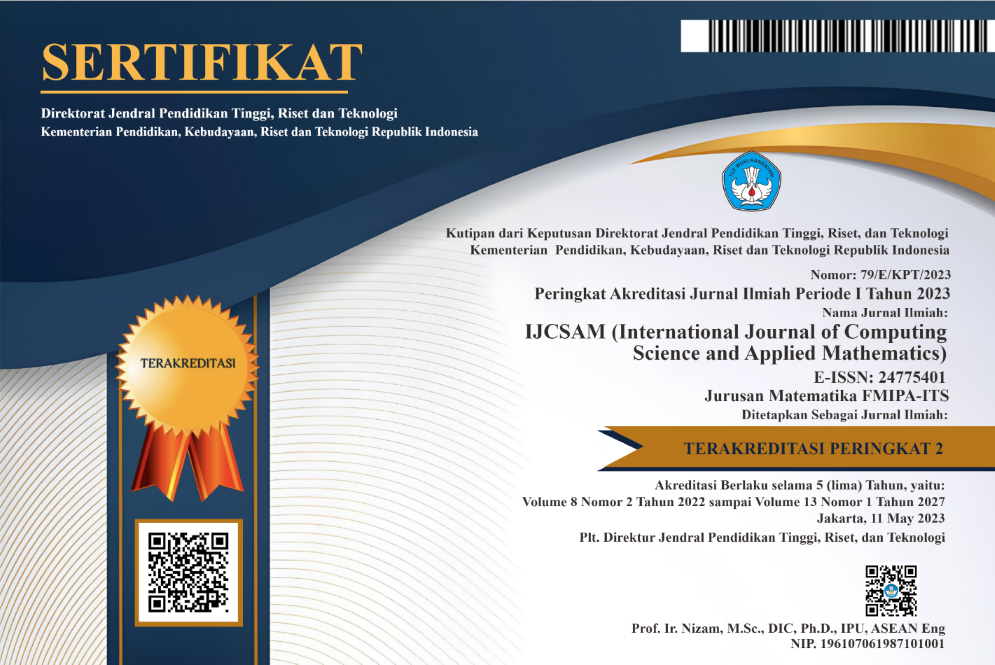Integration-Based Method as an Alternative Way to Estimate Parameters in the IV Bolus Compartment Model
Abstract
Keywords
Full Text:
PDFReferences
M. Gibaldi and D. Perrier, Pharmacokinetics. Informa, 2007.
M. A. Hedaya, Basic Pharmacokinetics. CRC Press, 2012.
M. Savva, “A mathematical treatment of multiple intermittent intra-
venous infusion in a one-compartment model,” Computer Methods and
Programs in Biomedicine, vol. 205, 2021.
M. Khanday, A. Rafiq, and K. Nazir, “Mathematical models for drug
diffusion through the compartments of blood and tissue medium,”
Alexandria Journal of Madicine, vol. 53, pp. 245–249, 2017.
V. S. R. K. Reddy and K. L. Narayah, “The concentration of digoxin
after intravenous and oral administration studied by a two-compartment
model,” Letters in Biomathematics, vol. 6, no. 2, 2019.
M. Rodrigo, “A laplace transform approach to direct and inverse
problems for multi-compartment models,” European Journal of Applied
Mathematics, vol. 33, no. 6, pp. 1–15, 2022.
O. Egbelowo, “Nonlinear elimination of drug in one-compartment
pharmacokinetic models: Nonstandard finite difference approach for
various routes of administration,” Mathematical and Computational
Applications, vol. 23, no. 27, 2018.
O. Egbelowo, C. Harley, and B. Jacobs, “Nonstandard finite difference
method applied to a linear pharmacokinetics model,” Bioengineering,
vol. 4, no. 40, 2017.
C. N. Angstmann, B. I. Henry, B. A. Jacobs, and A. V. McGann, “An explicit numerical scheme for solving fractional order compartment models from the master equations of a stochastic process,” Communications in Nonlinear Science and Numerical Simulation, vol. 68, pp. 188–202, 2019.
C. N. Angstmann, A. M. Erickson, B. I. Henry, A. V. McGann, J. M.
Murray, and J. A. Nichols, “Fractional order compartment models,”
SIAM Journal on Applied Mathematics, vol. 77, pp. 430–446, 2017.
S. Mtshali and B. A. Jacobs, “On the validation of a fractional order
model for pharmacokinetics using clinical data,” Fractal and Fractional,
vol. 7, no. 1, p. 84, 2023.
P. Sopasakis, H. Sarimveis, P. Macheras, and A. Dokoumetzidis, “Fractional calculus in pharmacokinetics,” Journal of Pharmacokinetics and Pharmacodynamics, vol. 45, pp. 107–125, 2018.
F. R. Giordano, W. P. Fox, and S. B. Horton, A First Course in
Mathematical Modeling. Brooks/Cole, 2014.
L. Shargel and A. B. C. Yu, Applied Biopharmaceutics and Pharma-
cokinetics. McGraw-Hill, 2005.
J. G. Wagner and E. Nelson, “Percent absorbed time plots derived from blood level and/or urinary excretion data,” J. Pharm. Sci., vol. 52, pp.610–611, 1963.
J. C. K. Loo and S. Riegelman, “New method for calculating the intrinsic absorption rate of drugs,” J. Pharm. Sci., vol. 57, no. 6, pp. 918–928, 1968.
J. G. Wagner, “Application of the loo-riegelman absorption method,”
Journal of Pharmacokinetics and Biopharmaceutics, vol. 3, no. 1, 1975.
A. B. Holder and M. R. Rodrigo, “An integration-based method for
estimating parameters in a system of differential equations,” Applied
Mathematics and Computation, vol. 219, pp. 9700–9708, 2013.
D. Zulkarnaen and M. R. Rodrigo, “Modelling human carrying capacity as a function of food availability,” ANZIAM Journal, vol. 62, pp. 318–333, 2020.
DOI: http://dx.doi.org/10.12962%2Fj24775401.v10i1.18704
Refbacks
- There are currently no refbacks.
View My Stats

International Journal of Computing Science and Applied Mathematics by Pusat Publikasi Ilmiah LPPM, Institut Teknologi Sepuluh Nopember is licensed under a Creative Commons Attribution-ShareAlike 4.0 International License.
Based on a work at https://iptek.its.ac.id/index.php/ijcsam.






